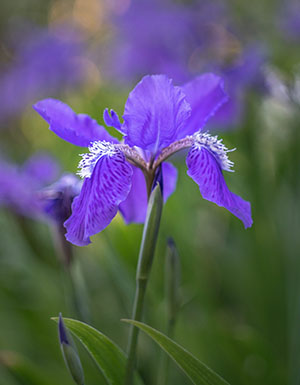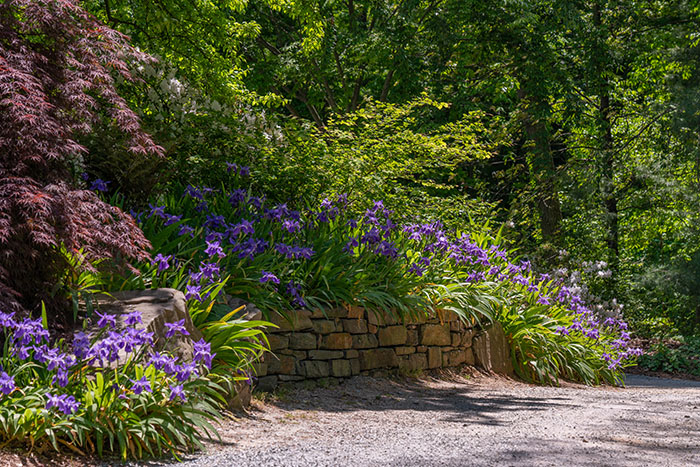Garden Talk

Botanical name: Iris tectorum
Common name: Japanese roof iris, wall iris
Family name: Iridaceae (Iris family)
Native range: China
Location in Duke Gardens: Culberson Asiatic Arboretum, Doris Duke Center Gardens
USDA Hardiness Zones: 4-9
By Katherine Hale
Marketing & Communications Assistant

Named for the Greek goddess of the rainbow, iris flowers are both beautiful and surprisingly complex in structure. The fan-shaped flowers consist of three downward drooping sepals, or modified leaves that protect the flower when in bud and also known as “falls,” which may be decorated with lines, dots, veins, fringes or strips of fuzzy “beards.” Along with the sepals are three upright true petals clustered at the center, known as “standards”.
With more than 300 species and many naturally occurring hybrids, irises are grouped by their growth form (bulbous or rhizomatous) and their flowers (bearded or unbearded). Even without digging, it’s easy to tell which group is which: rhizomatous species have flattened, sword-shaped leaves and grow in dense, spreading clumps, while bulbous species have cylindrical leaves and a more compact form. Thus, a quick glance at the Japanese roof iris (Iris tectorum) places it in the group of rhizamatous unbearded irises, or crested irises (subgenus Limniris), also known as “pond irises” for their propensity to grow in moist, damp locations.
Despite its common name, this species is originally native to China, where it grows in abundance in sunny meadows, forest edges, streambanks, roadsides and steep hillsides. Once introduced to Japan, it quickly became a popular ornamental plant, where it is known as ichihatu, or the first iris to flower each year. European visitors to the country in the 1870s first encountered it growing happily on top of thatched roofs, and the nickname stuck in multiple languages (tectorum is Latin for "of roofs").
Like its namesake rainbow, I. tectorum comes in a wide variety of colors, from deep purple to lavender to completely white to pale blue with speckled falls and a fuzzy white fringe. This highly versatile species can be planted in wet areas or dry rock gardens, but they prefer a sunny to part-shade location in rich, well-drained soil, and they benefit from the shelter of a wall with western or southern exposure—hence, another common name, “wall iris.” Look for the thriving colony atop one such wall in the East Meets West Garden that connects the Doris Duke Center Gardens to the Culberson Asiatic Arboretum, backdropped by white azaleas (Rhododendron sp.) and sheltered beneath the canopy of a venerable ornamental crabapple (Malus sp.)
Photos from top: Japanese roof irises beneath the canopy of an ornamental crabapple in the East Meets West Garden, by Bob Ayers; close-up of a Japanese roof iris flower, by Clarence Burke; Japanese roof irises growing along a stone wall in the East Meets West Garden, by Clarence Burke.






